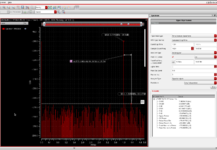r.mirtaji
Junior Member level 3
i designed an Eight-bit digital-to-analog converter based on MOSFET
In order to check the dynamic performance of the converter, I have used the following circuit
The characteristics of the converter are as follows:
Fin=2.451171875000000e+06 (input frequency)
Fs=10M (sample frequency)
N=1024; (Number of sample)

The dynamic characteristic is obtained as follows
Fin=2.5M ====><<ENOB=7.9859418 , SINAD=49.83831 , SFDR=66.166519>>

When I change the input frequency, the dynamic characteristic does not change and is almost constant!
Fin=4M ====><<ENOB=7.9859418 , SINAD=49.83831 , SFDR=66.166519>>

1-Shouldn't the ENOB and SFDR decrease by increasing the input frequency?
2-To express the performance of the converter, do we draw the graph of
the ENOB according to the frequency or the ENOB according to the sampling frequency


Why doeas the ENOB and SFDR not decreased with increasing frequency?

The converter circuit is as follows
In order to check the dynamic performance of the converter, I have used the following circuit
The characteristics of the converter are as follows:
Fin=2.451171875000000e+06 (input frequency)
Fs=10M (sample frequency)
N=1024; (Number of sample)
The dynamic characteristic is obtained as follows
Fin=2.5M ====><<ENOB=7.9859418 , SINAD=49.83831 , SFDR=66.166519>>
When I change the input frequency, the dynamic characteristic does not change and is almost constant!
Fin=4M ====><<ENOB=7.9859418 , SINAD=49.83831 , SFDR=66.166519>>

1-Shouldn't the ENOB and SFDR decrease by increasing the input frequency?
2-To express the performance of the converter, do we draw the graph of
the ENOB according to the frequency or the ENOB according to the sampling frequency
Why doeas the ENOB and SFDR not decreased with increasing frequency?
The converter circuit is as follows